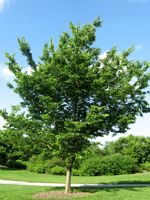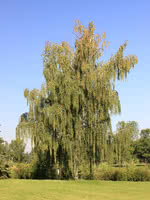Mon-Fri 9am - 5pm Mountain time
Common Hackberry vs Cutleaf Weeping Birch
Celtis occidentalis
Betula pendula laciniata
The Common Hackberry is a medium-sized deciduous tree that resembles the American Elm but is immune to Dutch Elm Disease. They are versatile and can adapt to a variety of growing conditions.
It produces purple-red, berry-like fruit with a large seed in the center. Both the sweet flesh, which tastes similar to dates, and the crunchy seed are edible. The fruit remains on the tree throughout the winter, offering a valuable food source for birds and other wildlife.
The Common Hackberry can also be a great addition to a pollinator garden. The tree itself is a host for the larvae of several butterfly species and the flowers provide a source of pollen and nectar.
Cutleaf Weeping Birch is a tall, deciduous cultivar known for its pronounced weeping branches and ferny green leaves.
It features showy, peeling white bark and brilliant yellow leaves in the fall. Cutleaf Weeping Birch makes an exceptional accent tree for suburban yards.
If you are attracted to this tree, also look at the European White Birch which is similar.

